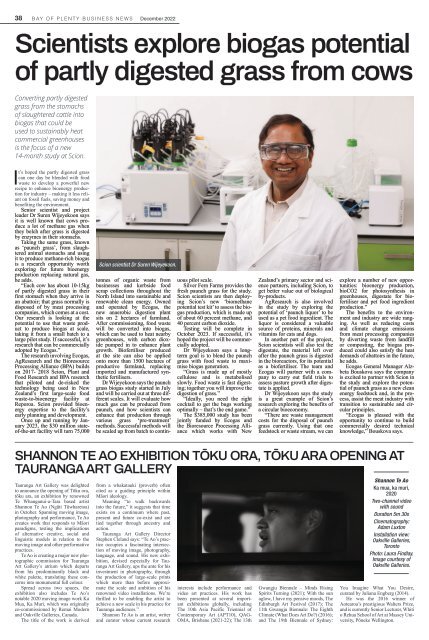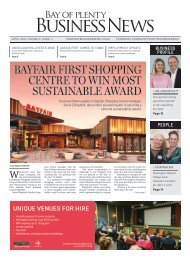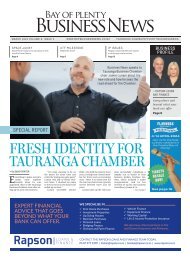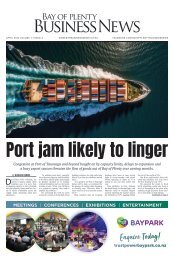December 2022 - Bay of Plenty Business News
From mid-2016 Bay of Plenty businesses have a new voice, Bay of Plenty Business News. This new publication reflects the region’s growth and importance as part of the wider central North Island economy.
From mid-2016 Bay of Plenty businesses have a new voice, Bay of Plenty Business News. This new publication reflects the region’s growth and importance as part of the wider central North Island economy.
You also want an ePaper? Increase the reach of your titles
YUMPU automatically turns print PDFs into web optimized ePapers that Google loves.
38 BAY OF PLENTY BUSINESS NEWS <strong>December</strong> <strong>2022</strong><br />
Scientists explore biogas potential<br />
<strong>of</strong> partly digested grass from cows<br />
Converting partly digested<br />
grass from the stomachs<br />
<strong>of</strong> slaughtered cattle into<br />
biogas that could be<br />
used to sustainably heat<br />
commercial greenhouses<br />
is the focus <strong>of</strong> a new<br />
14-month study at Scion.<br />
It’s hoped the partly digested grass<br />
can one day be blended with food<br />
waste to develop a powerful new<br />
recipe to enhance bioenergy production<br />
for industry – making it less reliant<br />
on fossil fuels, saving money and<br />
benefiting the environment.<br />
Senior scientist and project<br />
leader Dr Suren Wijeyekoon says<br />
it is well known that cows produce<br />
a lot <strong>of</strong> methane gas when<br />
they belch after grass is digested<br />
by enzymes in their stomachs.<br />
Taking the same grass, known<br />
as ‘paunch grass’, from slaughtered<br />
animal stomachs and using<br />
it to produce methane-rich biogas<br />
is a research opportunity worth<br />
exploring for future bioenergy<br />
production replacing natural gas,<br />
he adds.<br />
“Each cow has about 10-15kg<br />
<strong>of</strong> partly digested grass in their<br />
first stomach when they arrive in<br />
an abattoir; that grass normally is<br />
disposed <strong>of</strong> by meat processing<br />
companies, which comes at a cost.<br />
Our research is looking at the<br />
potential to use that waste product<br />
to produce biogas at scale,<br />
taking it from a small batch to a<br />
large pilot study. If successful, it’s<br />
research that can be commercially<br />
adopted by Ecogas.”<br />
The research involving Ecogas,<br />
AgResearch and the Bioresource<br />
Processing Alliance (BPA) builds<br />
on 2017- 2018 Scion, Plant and<br />
Food Research and BPA research<br />
that piloted and de-risked the<br />
technology being used in New<br />
Zealand’s first large-scale food<br />
waste-to-bioenergy facility at<br />
Reporoa. Scion provided bioenergy<br />
expertise to the facility’s<br />
early planning and development.<br />
Once up and running by January<br />
2023, the $30 million state<strong>of</strong>-the-art<br />
facility will turn 75,000<br />
Scion scientist Dr Suren Wijeyekoon.<br />
tonnes <strong>of</strong> organic waste from<br />
businesses and kerbside food<br />
scrap collections throughout the<br />
North Island into sustainable and<br />
renewable clean energy. Owned<br />
and operated by Ecogas, the<br />
new anaerobic digestion plant<br />
sits on 2 hectares <strong>of</strong> farmland.<br />
After commissioning, food waste<br />
will be converted into biogas,<br />
which can be used to heat nearby<br />
greenhouses, with carbon dioxide<br />
pumped in to enhance plant<br />
growth. Bi<strong>of</strong>ertiliser produced<br />
at the site can also be applied<br />
onto more than 1500 hectares <strong>of</strong><br />
productive farmland, replacing<br />
imported and manufactured synthetic<br />
fertilisers.<br />
Dr Wijeyekoon says the paunch<br />
grass biogas study started in July<br />
and will be carried out at three different<br />
scales. It will evaluate how<br />
much gas can be produced from<br />
paunch, and how scientists can<br />
enhance that production through<br />
various grass ‘pre-treatment’<br />
methods. Successful methods will<br />
be scaled up from batch to continuous<br />
pilot scale.<br />
Silver Fern Farms provides the<br />
fresh paunch grass for the study.<br />
Scion scientists are then deploying<br />
Scion’s new ‘biomethane<br />
potential test kit’ to assess the biogas<br />
production, which is made up<br />
<strong>of</strong> about 60 percent methane, and<br />
40 percent carbon dioxide.<br />
Testing will be complete in<br />
October 2023. If successful, it’s<br />
hoped the project will be commercially<br />
adopted.<br />
Dr Wijeyekoon says a longterm<br />
goal is to blend the paunch<br />
grass with food waste to maximise<br />
biogas generation.<br />
“Grass is made up <strong>of</strong> mostly<br />
cellulose and is metabolised<br />
slowly. Food waste is fast digesting;<br />
together you will improve the<br />
digestion <strong>of</strong> grass.”<br />
“Ideally, you need the right<br />
cocktail to get the bugs working<br />
optimally – that’s the end game.”<br />
The $385,000 study has been<br />
jointly funded by Ecogas and<br />
the Bioresource Processing Alliance<br />
which works with New<br />
Zealand’s primary sector and science<br />
partners, including Scion, to<br />
get better value out <strong>of</strong> biological<br />
by-products.<br />
AgResearch is also involved<br />
in the study by exploring the<br />
potential <strong>of</strong> ‘paunch liquor’ to be<br />
used as a pet food ingredient. The<br />
liquor is considered a valuable<br />
source <strong>of</strong> proteins, minerals and<br />
vitamins for cats and dogs.<br />
In another part <strong>of</strong> the project,<br />
Scion scientists will also test the<br />
digestate, the material left over<br />
after the paunch grass is digested<br />
in the bioreactors, for its potential<br />
as a bi<strong>of</strong>ertiliser. The team and<br />
Ecogas will partner with a company<br />
to carry out field trials to<br />
assess pasture growth after digestate<br />
is applied.<br />
Dr Wijeyekoon says the study<br />
is a great example <strong>of</strong> Scion’s<br />
research exploring the benefits <strong>of</strong><br />
a circular bioeconomy.<br />
“There are waste management<br />
costs for the disposal <strong>of</strong> paunch<br />
grass currently. Using that one<br />
feedstock or waste stream, we can<br />
explore a number <strong>of</strong> new opportunities:<br />
bioenergy production,<br />
bioCO2 for photosynthesis in<br />
greenhouses, digestate for bi<strong>of</strong>ertiliser<br />
and pet food ingredient<br />
production.”<br />
The benefits to the environment<br />
and industry are wide ranging.<br />
As well as reducing costs<br />
and climate change emissions<br />
from meat processing companies<br />
by diverting waste from landfill<br />
or composting, the biogas produced<br />
could also satisfy the heat<br />
demands <strong>of</strong> abattoirs in the future,<br />
he adds.<br />
Ecogas General Manager Alzbeta<br />
Bouskova says the company<br />
is excited to partner with Scion in<br />
the study and explore the potential<br />
<strong>of</strong> paunch grass as a new clean<br />
energy feedstock and, in the process,<br />
assist the meat industry with<br />
transition to sustainable and circular<br />
principles.<br />
“Ecogas is pleased with the<br />
opportunity to continue to build<br />
commercially desired technical<br />
knowledge,” Bouskova says.<br />
SHANNON TE AO EXHIBITION TŌKU ORA, TŌKU ARA OPENING AT<br />
TAURANGA ART GALLERY<br />
Tauranga Art Gallery was delighted<br />
to announce the opening <strong>of</strong> Tōku ora,<br />
tōku ara, an exhibition by renowned<br />
Te Whanganui-a-Tara based artist<br />
Shannon Te Ao (Ngāti Tūwharetoa)<br />
in October. Spanning moving image,<br />
photography and performance, Te Ao<br />
creates work that responds to Māori<br />
paradigms, testing the implications<br />
<strong>of</strong> alternative creative, social and<br />
linguistic models in relation to the<br />
moving image and other performative<br />
practices.<br />
Te Ao is creating a major new photographic<br />
commission for Tauranga<br />
Art Gallery’s atrium which departs<br />
from his predominantly black and<br />
white palette, translating these concerns<br />
into monumental full colour.<br />
Spread across two spaces, the<br />
exhibition also includes Te Ao’s<br />
notable 2020 moving image work Ka<br />
Mua, Ka Muri, which was originally<br />
co-commissioned by Remai Modern<br />
and Oakville Galleries, Canada.<br />
The title <strong>of</strong> the work is derived<br />
from a whakatauki (proverb) <strong>of</strong>ten<br />
cited as a guiding principle within<br />
Māori ideology.<br />
Meaning “to walk backwards<br />
into the future,” it suggests that time<br />
exists on a continuum where past,<br />
present and future co-exist and are<br />
tied together through ancestry and<br />
action.<br />
Tauranga Art Gallery Director<br />
Stephen Cleland says: “Te Ao’s practice<br />
occupies a fascinating intersection<br />
<strong>of</strong> moving image, photography,<br />
language, and sound. His new exhibition,<br />
devised especially for Tauranga<br />
Art Gallery, ups the ante for his<br />
investment in photography, through<br />
the production <strong>of</strong> large-scale prints<br />
which more than before approximate<br />
the scale and ambition <strong>of</strong> his<br />
renowned video installations. We’re<br />
thrilled to be enabling the artist to<br />
achieve a new scale in his practice for<br />
Tauranga audiences.”<br />
Shannon Te Ao is an artist, writer<br />
and curator whose current research<br />
interests include performance and<br />
video art practices. His work has<br />
been presented at several important<br />
exhibitions globally, including<br />
The 10th Asia Pacific Triennial <strong>of</strong><br />
Contemporary Art (APT10), QAG-<br />
OMA, Brisbane (2021-22); The 13th<br />
Gwangju Biennale – Minds Rising<br />
Spirits Turning (2021); With the sun<br />
aglow, I have my pensive moods, The<br />
Edinburgh Art Festival (2017); The<br />
11th Gwangju Biennale: The Eighth<br />
Climate (What Does Art Do?) (2016);<br />
and The 19th Biennale <strong>of</strong> Sydney:<br />
Shannon Te Ao<br />
Ka mua, ka muri,<br />
2020<br />
Two-channel video<br />
with sound<br />
Duration 5m 30s<br />
Cinematography:<br />
Adam Luxton<br />
Installation view:<br />
Oakville Galleries,<br />
Toronto<br />
Photo: Laura Findlay.<br />
Image courtesy <strong>of</strong><br />
Oakville Galleries.<br />
You Imagine What You Desire,<br />
curated by Juliana Engberg (2014).<br />
He was the 2016 winner <strong>of</strong><br />
Aotearoa’s prestigious Walters Prize,<br />
and is currently Senior Lecturer, Whiti<br />
o Rehua School <strong>of</strong> Art at Massey University,<br />
Pōneke Wellington.

















